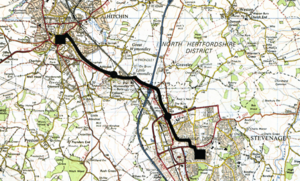Hitchin-Stevenage Fibre Optic trial facts for kids
In 1977, something amazing happened between the towns of Hitchin and Stevenage in the UK. Scientists showed that tiny glass threads, called optical fibres, could send huge amounts of information really fast over long distances. This was a super important step for how we communicate today!
For a while, smart people called physicists had been talking about using fibre optics for communication. In 1966, two scientists named Charles Kao and George Hockham from Standard Telecommunications Laboratories (STL) in Harlow, Essex, wrote about a big idea. They believed glass could be made so pure that it could send signals for hundreds of kilometres. Many people thought this was impossible!
But the scientists at STL teamed up with the British Post Office. They wanted to turn this big idea into a real working system. The trial was a huge success. It proved that optical fibres were the future. This work eventually led to Charles Kao winning a Nobel Prize in Physics for his groundbreaking ideas.
The Big Test
To show off this new technology, the scientists worked with the Post Office. They used existing underground pipes that connected the telephone buildings in Hitchin and Stevenage. The experts at STL and STC (Standard Telephones and Cables) Ltd. worked hard to make the best optical fibres and equipment.
They chose a route that was quite difficult to install. This was to really prove how strong and reliable the new fibre cables were. The goal was to show that the system could send data at 140 megabits per second (MB/s). This was the fastest digital speed available back then!
Work began in April 1977 to put the equipment in place. The total distance was about 9 kilometres (5.6 miles). They needed special signal boosters, called repeaters, every 3 kilometres to keep the signal strong.
The team faced many challenges during the installation. They found manholes filled with water, and had to carefully bend the fibre cables around tight corners. The route even crossed a railway line and a busy motorway! All these challenges showed how tough and reliable optical fibres were.
Once everything was set up, it quickly became clear that the technology worked perfectly. The signals sent from one town were clearly received at the other end.
The success of the Hitchin-Stevenage trial was a huge moment. It changed how we send information around the world forever.


